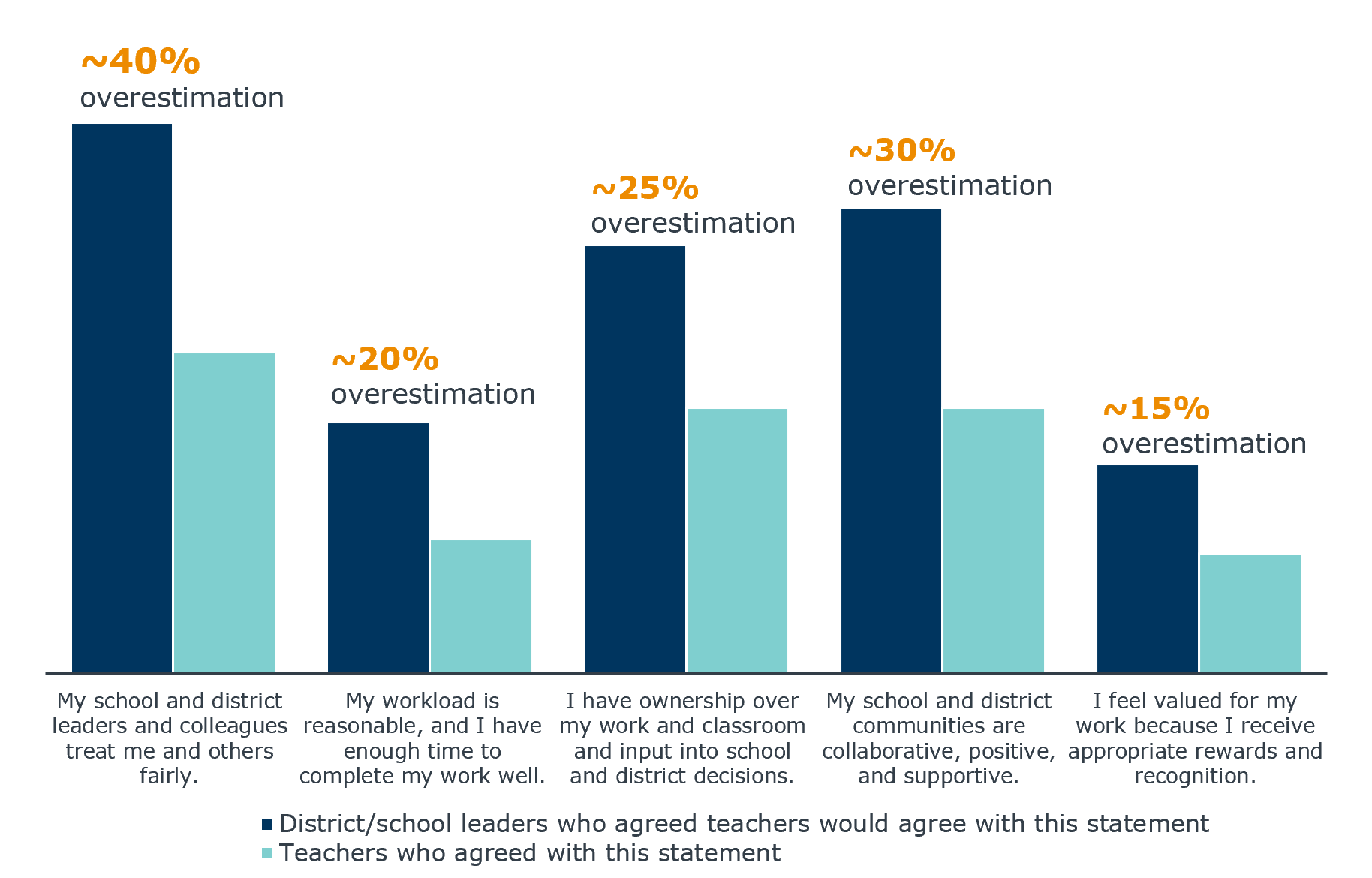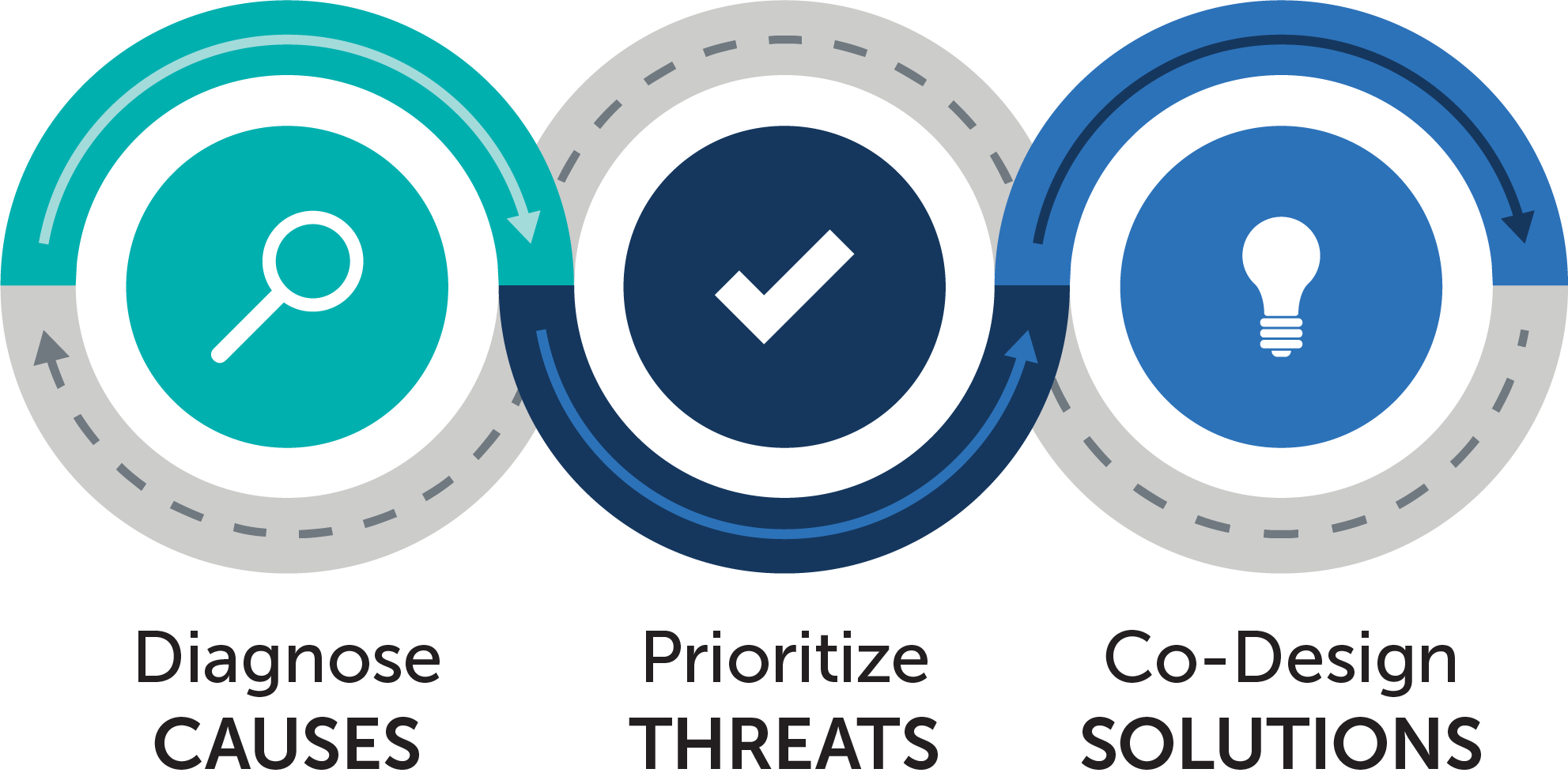A path forward to improve teacher morale
This fall EAB’s District Leadership Forum conducted a nationwide survey to measure the extent of and drivers behind low teacher morale. The survey captured the perspectives of both teachers and district/school leaders on teacher morale. More than 2,200 teachers and nearly 400 district and school leaders participated.
At a high level, the survey confirmed what we already knew from our daily conversations with the leaders of the roughly 200 school districts that partner with us: Teacher morale is at an all-time low. Nearly a third of teachers indicated they had low morale and two-thirds of teachers agreed their morale levels are lower today than five years ago.
As EAB wrote earlier this fall, teacher morale can make or break a district’s ability to achieve its goals. District leaders have to think and act differently to improve teacher morale to successfully tackle the unprecedented academic, emotional, and social challenges students are facing this year and beyond.
Below are key takeaways from EAB’s teacher morale survey results. We have also included recommendations for steps district leaders can take to improve teacher morale and working conditions.
Low teacher morale prevents teachers from performing at their best and obstructs new district initiatives
During dozens of EAB-conducted research interviews, superintendents shared countless stories about how low teacher morale has impeded district progress and caused challenges this year.
The survey results reflected these stories.
- 41% of teacher respondents agreed they ‘struggle to perform [their] best at work despite [their] best intentions.’ Reflecting one district leader’s sentiment about teachers’ struggling to perform at their best: “even my top performing teachers (who used to plan interactive lessons for students) are now using worksheets that require little planning.”
- 69% of teacher respondents did not agree they are ‘mentally ready to be the best teacher [they] can be for [their] students.’ And research shows that low teacher morale directly interferes with instructional quality and student engagement.
- Only 28% of teacher respondents agreed they were ‘eager to implement new school or district initiatives,’ during a year where districts need to move forward initiatives for learning acceleration and to support mental health needs.
Several superintendents report they have paused planned curriculum implementation and strategic plans due to low teacher morale. One superintendent shared the following:
“Even though we spent the last year designing our learning acceleration plans, those plans are now on hold because our teachers are rightfully too tired and will push back on any new initiatives that we introduce. It is not that they don’t want to serve students, it is just that they don’t have the mental bandwidth or stamina to take on anything new and do it well…We are likely going to wait until next year to introduce curriculum prioritization.”
Of course, teaching has always been a challenging profession. But superintendents agree this year is different—88% of district/school leader respondents agreed that teacher morale is lower today than five years ago.
After optimism this summer that teacher morale would rebound on its own, many district leaders now realize it has and will not—so they must act.
There is a significant disconnect between perceptions held by district leaders around morale and teachers’ attitudes
District leaders overestimated the percentage of teachers that would agree positively with statements related to the common drivers of morale (e.g., fairness, manageable workloads).
District and school leaders overestimate teachers’ agreement with several statements

This suggests that district leaders do not understand what negatively impacts teachers’ morale at any given moment. EAB research has revealed that district leaders must understand the why behind low morale before they will be able to improve it.
This begins to explain why many districts’ current efforts—often focused on wellness and teacher appreciation—have failed to meaningfully improve morale this year.
Districts must adopt a permanent, adaptive system that involves direct input from teachers to improve and sustain teacher morale
EAB’s teacher morale survey confirms that teacher morale is dangerously low. But low teacher morale—even during challenging times—isn’t inevitable.
EAB set out this fall to uncover key drivers that actually move the needle on teacher morale. To do this, we not only surveyed district leaders and teachers, but we also turned to decades of psychological research on human motivation and studied dozens of organizations across industries to determine how to successfully improve and sustain employee morale.
Through this research, EAB uncovered a handful of outlier organizations across industries that improved employee morale effectively and efficiently, despite challenging times.
Their success was not defined by a one-size-fits-all or predetermined set of strategies to boost and sustain morale.
Instead, their success shared one common ingredient: all outlier organizations adopted a scientific mindset and integrated a morale momentum loop that continuously diagnoses the evolving needs of employees and co-develops and adjusts morale improvement solutions in collaboration with employees.
Instead of trying to improve morale in reaction to every new challenge a district or teachers face, districts need to make a sustained investment in improving working conditions for teachers to bolster school and district effectiveness. By adopting this loop, districts will achieve reliably high teacher morale and improve their districts’ ability to achieve its ever-expanding goals.
EAB’s teacher morale momentum loop

EAB broke down this momentum loop into three parts districts should use to permanently embed this system into their district processes:
1. Diagnose why morale is low by collecting consistent qualitative and quantitative teacher input
To successfully improve morale, leaders must align their perceptions of teacher morale drivers with teachers’ actual wants and needs. Most districts do not have a system in place that diagnoses the why behind low morale nor collects the information frequently enough. The pandemic has made it evident how often teachers’ needs change even over the course of one school year.
Most school districts (80% of district leaders respondents who measure morale at all) rely on an annual ‘climate survey’ measurement approach. But best practice organizations focus on shorter, more targeted feedback collection at least quarterly. They also embed ways to balance quantitative feedback with qualitative input to dig deeper into the root drivers of morale concerns, so they can better target solutions.
How EAB can help:
EAB is designing a quarterly morale diagnosis instrument (and related tools) that districts will be able to use to better understand their biggest threats to morale at any given time. This instrument will be available to all partners by spring 2022.
2. Prioritize the threats and possible remedies
Once organizations diagnose the reasons behind low morale, too often their next step is to throw a bunch of possible remedies at the most common set of problems that teachers raise. As a result, leaders attempt more than they can realistically address, which undermines trust and does not effectively improve teacher morale.
Instead, school districts must prioritize tackling 1-2 root causes of morale at a time based on the potential impact on morale and the feasibility for the district to effectively act on that root cause. District and school leaders must also be mindful of consistently communicating feedback results, planned next steps, and rationale to teachers to keep them engaged and active participants in the momentum loop.
How EAB can help:
EAB is creating a prioritization matrix to help individual districts decide what threats to address to improve morale most successfully. In addition, we are developing communication timelines and templates for district and building leaders to use.
3. Involve teachers in co-designing solutions by lowering participation barriers
The best organizations realize that top-down implementation of morale improvement strategies is usually ineffective. Grassroots efforts and strategies designed by teachers work better. However, most teachers do not have the time or bandwidth to design anything new—especially if the task does not relate to educating students.
Districts must find ways to lower the participation barriers to solution development and avoid putting teachers on the hook to design solutions from scratch to improve their own morale. Instead, district leaders should offer a menu of ideas that teachers can help refine. Leaders should also integrate time for this into existing structures and incentives.
How EAB can help:
EAB is designing a menu of proven morale-improvement strategies partners can use with teachers to ideate and refine solutions. We are also sourcing best practices from school districts on how they involve teachers without asking for too much of their time.

Featured Resource

Teacher Morale Resource Center for K-12 Districts
More Blogs

How K-12 leaders can build a sustainable work environment
